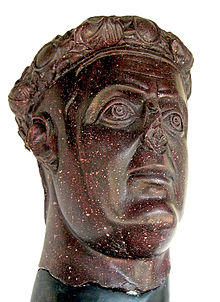Galerius
| Galerius | |||||
|---|---|---|---|---|---|

Porphyry bust of Galerius
|
|||||
| Joint 53rd Emperor of the Roman Empire | |||||
| Reign | 1 March or 21 May 293 – 1 May 305 (as Caesar, under Diocletian) 1 May 305 – late April or early May 311 (as Augustus alongside Constantius (until July 25, 306) then Severus (until spring 307) then Constantine (from ca. September 307; unrecognized by Galerius' coinage from ca. September 307 to November 308) then Licinius (from 11 November 308)) |
||||
| Predecessor | Maximian and Diocletian | ||||
| Successor | Maximinus, Constantine, and Licinius | ||||
| Born |
ca. 260 Serdica (Sofia, Bulgaria) |
||||
| Died | Late April or early May 311 (aged 51) Serdica (Sofia), Bulgaria |
||||
| Burial | Serdica or Felix Romuliana (Gamzigrad) | ||||
| Spouse | Galeria Valeria | ||||
| Issue | Candidianus Valeria Maximilla, Roman Empress |
||||
|
|||||
| Mother | Romula (alleged) | ||||
| Full name | |
|---|---|
| Gaius Galerius Valerius Maximianus Augustus |
Galerius (/ɡəˈlɛəriəs/; Latin: Gaius Galerius Valerius Maximianus Augustus; c. 260 – April or May 311) was Roman Emperor from 305 to 311. During his reign he campaigned, aided by Diocletian, against the Sassanid Empire, sacking their capital Ctesiphon in 299. He also campaigned across the Danube against the Carpi, defeating them in 297 and 300. Although he was a staunch opponent of Christianity, Galerius ended the Diocletianic Persecution when he issued an edict of toleration in 311.
Galerius was born in Serdica, though some modern scholars consider the strategic site where he later built his palace named after his mother – Felix Romuliana (Gamzigrad) – his birth and funeral place. His father was a Thracian and his mother Romula was a Dacian woman, who left Dacia because of the Carpians' attacks. He originally followed his father's occupation, that of a herdsman, where he got his surname of Armentarius (Latin: armentum, herd).
He served with distinction as a soldier under Emperors Aurelian and Probus, and in 293 at the establishment of the Tetrarchy, was designated Caesar along with Constantius Chlorus, receiving in marriage Diocletian's daughter Valeria (later known as Galeria Valeria), and at the same time being entrusted with the care of the Illyrian provinces. After a few years campaigning against Sarmatians and Goths on the Danube, he received command of the legions on the eastern Imperial limits. Soon after his appointment, Galerius would be dispatched to Egypt to fight the rebellious cities Busiris and Coptos.
...
Wikipedia
